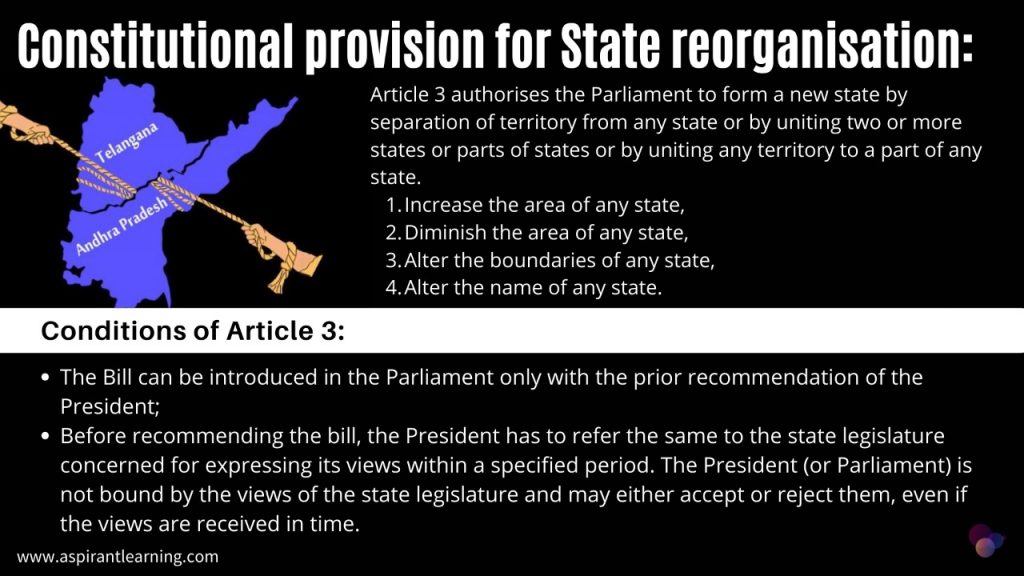News Highlights:
- The stalemate between Telangana and AP has continued for more than eight years after the bifurcation of the erstwhile united Andhra Pradesh.
- Andhra Pradesh government has now approached the Supreme Court seeking “just, reasonable and equitable apportionment” of assets and liabilities.
Key takeaway:
Division of assets and liabilities between the two States remains elusive as the States make their own interpretation of the provisions under the Andhra Pradesh Reorganisation Act 2014.
What assets are to be divided:
- Schedule IX and Schedule X assets:
- There are 91 institutions under Schedule IX of the Andhra Pradesh Reorganisation Act 2014.
- There are 142 institutions under Schedule X of the Andhra Pradesh Reorganisation Act 2014.
- The issue involves 245 institutions with a total fixed asset value of ₹1.42 lakh crore.
- Headquarter assets under Schedule IX institutions are pegged at ₹24,018.53 crores, while institutions under Schedule X are at ₹34,642.77 crores.
- The division of another 12 institutions valued at ₹1,759 crores not mentioned in the Act has also become contentious between the States.

Andhra Pradesh Reorganisation Act, 2014:
- About:
- Andhra Pradesh Reorganisation Act, 2014 is an Act of the Indian Parliament that bifurcated the state of Andhra Pradesh into Telangana and the residuary Andhra Pradesh state.
- The bill was introduced on 5 December 2013, the first day of the winter session in the Legislative Assembly of Andhra Pradesh. The official formation of the 2 separate states was 2nd June 2014.
- The new state of Telangana was formed with ten districts.
- Sections, Schedules and parts:
- 108 sections and
- 13 Schedules
- 12 Parts
Highlights of the Reorganisation Act, 2014:
- Capital:
- Hyderabad is to be the shared capital for the States of Telangana and Andhra Pradesh for a period not exceeding ten years.
- After the expiry of the period, Hyderabad shall be the capital of the State of Telangana, and there shall be a new capital for the State of Andhra Pradesh.
- Expert committee:
- The Central Government shall constitute an expert committee to study various alternatives regarding the new capital for the successor State of Andhra Pradesh and make appropriate recommendations in a period not exceeding six months from the date of enactment of the Andhra Pradesh Reorganisation Act, 2014.
- Governor:
- On and from the appointed day, the Governor of the existing State of Andhra Pradesh shall be the Governor for both the successor States of Andhra Pradesh and Telangana for such period as may be determined by the President.
- Amendments:
- The provisions of the Act made amendments to the First and Fourth Schedules of the Constitution.
- The number of seats in the Legislative Assemblies of the States of Andhra Pradesh and Telangana, on and from the appointed day, shall be 175 and 119, respectively.
- A Legislative Council shall be constituted for each successor State, consisting of less than [58 members in the Legislative Council of Andhra Pradesh] and 40 members in the Legislative Council of Telangana by the provisions contained in article 169 of the Constitution.
- The existing Legislative Council of the State of Andhra Pradesh shall, on and from the appointed day, be deemed to have been constituted as two Legislative Councils of the successor States, and the existing members shall be allotted to the Councils as specified in the Fourth Schedule.
- High Court Jurisdiction:
- On and from the appointed day, the High Court of Judicature at Hyderabad shall be the common High Court for the State of Telangana and the State of Andhra Pradesh till a separate High Court for the State of Andhra Pradesh is constituted under article 214 of the Constitution.
- The principal seat of the High Court of Andhra Pradesh shall be at such place as the President may, by notified order, appoint.
Constitutional provision for State reorganisation:
- Article 3 authorises the Parliament to
- Form a new state by separation of territory from any state or by uniting two or more states or parts of states or by uniting any territory to a part of any state.
- Increase the area of any state,
- Diminish the area of any state,
- Alter the boundaries of any state,
- Alter the name of any state.
- Form a new state by separation of territory from any state or by uniting two or more states or parts of states or by uniting any territory to a part of any state.
- Conditions of Article 3:
- The Bill can be introduced in the Parliament only with the prior recommendation of the President;
- Before recommending the bill, the President has to refer the same to the state legislature concerned for expressing its views within a specified period. The President (or Parliament) is not bound by the views of the state legislature and may either accept or reject them, even if the views are received in time.
Pic Courtesy: The Hindu
Content Source: The Hindu



